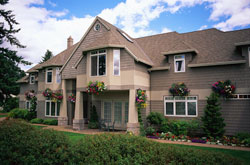Improve Your Home Energy Efficiency
See if We Have Top-Rated
Insulation Contractors in Your Area

Improving energy efficiency is a great home improvement goal. It can be tackled from several different angles, but the best projects will help you save money on your utility bills and help the local and global environment. Creating and prioritizing a list of projects that will improve the energy efficiency of your home is helpful in knowing where to begin. The general condition of your home, your local climate, and your budget are all important factors in determining how to make the best list possible.
1. Improve Energy Efficiency with Insulation
Inadequate insulation and air leakage are the two leading causes of energy waste. Since the average home uses over half its total energy demand on heating and cooling adding new insulation to your home usually dramatically reduces your utility bill. Given the right circumstances and insulation, the project can pay for itself in just a few short years and will add to the resale value of your home. Often, the best place to start is the roof. As heat rises, a larger percentage of energy is often lost through the roof than any other area of the home. Be careful, though, a leaky roof or attic pests can quickly ruin your roof insulation, and you may also need to add roof ventilation to protect your insulation, your roof, and your attic.
Other than roof ventilation, basement ventilation is probably the most common and best insulation project for your home. It can help prevent cold floors in your home, enhance your home's overall insulating value, and possibly create an extra livable space within your home.
Tips to Fix Common Insulation Issues
Make an Energy Wise Investment in Your Home! Click Here to
Upgrade Your Insulation
2. Windows, Doors, and Home Energy Efficiency
Per square foot, windows and doors are the greatest areas of poor insulation and air leakage. Replacement windows can noticeably increase home energy efficiency without the cost of a major home renovation. In fact, high performing double or triple glazed windows can create insulating values on par with your insulated walls. Doors, especially wood doors, may have warped slightly over time or become loose from their jambs, creating an uncomfortable draft and ruining the energy efficiency of that area of your home. Weatherstripping and/or door repair can remedy this problem. Replacement doors can create an even greater air seal and may add to the your home's interior decor and exterior curb appeal.
3. HVAC and Other Appliances
Heating, cooling, and ventilation systems consistently make technological strides in performance and energy efficiency. Even a heating and cooling system from five or ten years ago may be out-of-date with today's systems. This doesn't mean you need to have your system replaced, but if you have an older system or are having problems with your current system, you may benefit from an overhaul. New furnaces, heat pumps, and other heat sources can generate more heat from less energy use. New systems can also more efficiently move the heat throughout your home. Hydronic heating will not only reduce your energy demand, it will also create a dramatically more uniform and comfortable heat level.
4. Energy Conservation Habits
You don't need to be told again that turning off lights, turning the thermostat down an extra degree or two, and setting your hot water heater no higher than 120 degrees will help your home conserve energy. Major appliances, such as refrigerators, that aren't up-to-date can also eat away at your energy savings. These practices and smaller projects probably won't save as much energy as home renovations, but they also don't cost you much, if any, money. In other words, either start or keep turning your lights off when you don't need them, but don't think these habits mean you've suddenly created an energy efficient home.
More Tips & Advice For Your Home
- Related Articles
-

